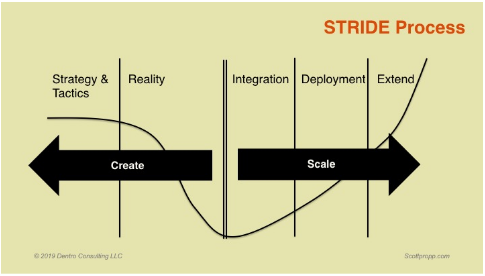When I walked into the conference room I could sense the tension immediately.
One of the groups in the room had developed new and powerful insights and had gotten those insights to the point where they needed real backing to move toward a new service product.
The second group was as dug in as the first group was excited. This group was accountable for delivering the goods, every day – just like clockwork. They had very expensive investments in people, processes and systems that they felt powerful ownership of.
These two groups were in the middle of a heated debate – and facing the dreaded Gap.
Why does this play out so often in complex existing firms?
There are actually several reasons, but for today let’s focus on one: an over-dependence on process.
The process they were using to connect those insights to their P&L was the same one they used for all of their core product development. And while those systems were great for working the pipeline of core market products, there are large assumptions embedded into those tools that keep firms from getting value from their valuable NEW insights.
After all, using your core product development process for your breakout work is like trying to drive a golf ball without a backswing: it’s very likely that you will develop no power at all, and that the growth project will stall before it even gets started.
Your best work demands a more flexible, tight and powerful approach. In our work with teams, we use my STRIDE Process to help teams get the most juice from the hard work they put into finding insights from their core and adjacent markets – even with the pressures of the ever-increasing pace of change and the shortage of precious talent.
Unpacking the STRIDE Model
 The right-hand side of the STRIDE model has the traditional elements of product development and uses tools such as stage gates, lean and six sigma that make use of the firm’s core processes.
The right-hand side of the STRIDE model has the traditional elements of product development and uses tools such as stage gates, lean and six sigma that make use of the firm’s core processes.
On the left-hand side is where the power is developed. For today’s post, let’s drill into the important phases on this side of the model so we can better understand how to avoid a misstep during your next growth project:
- The ST portion of the STRIDE curve stands for Strategy and Tactics. Using the talent of the firm and strategic outside resources, we build a small, cross-functional team to completely detail the red hot client job to be done. This includes enterprise tactical advantage, go-to-market alignment, and journey and ecosystem maps that complete a comprehensive business case. We then ruthlessly interrogate the business case for assumptions and areas of confirmation bias. We build that into a tornado diagram that quantifies the risk and drives our next phase.
- The R portion of the curve is where the team builds tightly scripted experiments to systematically remove the fiction. This can involve the development of wireframes and prototypes that allow high learning, value interactions with clients, beta agreements with development partners on services and ride alongs to assess the distribution and go-to-market team compatibility (as examples). The principle here is to take on the “killer” risks first and systematically set the work done in ST on a solid foundation.
Contrast this with the typical process of dropping the project outline at the front end of the traditional product development process. When the first significant hurdle is reached, momentum is completely lost and the initiative gets labeled and sent to the land of misfit toys.
It is very important to do the work of breakthrough business case development offline, and in an environment where the complete context can be considered and matured before engaging the large engine of scale. This allows large risks (that the optimization engine is just not set up to work on) to be worked out first.
The key to this working is to have as much discipline in building the muscle on the left as we have in the implementation engine on the right. Many teams who attempt to “free form” the left side of this work find that it doesn’t turn out well, as the expectations and rigor of the right side will quickly find a way to derail the potentially important work that your early insights have gotten started.
Last and finally, this is a problem that needs work at the mindset level. The conference room I had walked into was in tension because they all saw the same set of facts with a different mindset or baseline context. The work of moving them forward is helping them to see the net benefit and giving them a foundation to appreciate the wisdom and knowledge they all bring to the table. By helping them see the needed view they each bring, things get better fast and progress is made.
If you’d like to talk more about what it takes to have a successful journey through the early phases of installing new growth projects in firms, we should talk. Please reach out by using this link. Or give me a call at (847) 651-1014.
Related posts you can benefit from…


